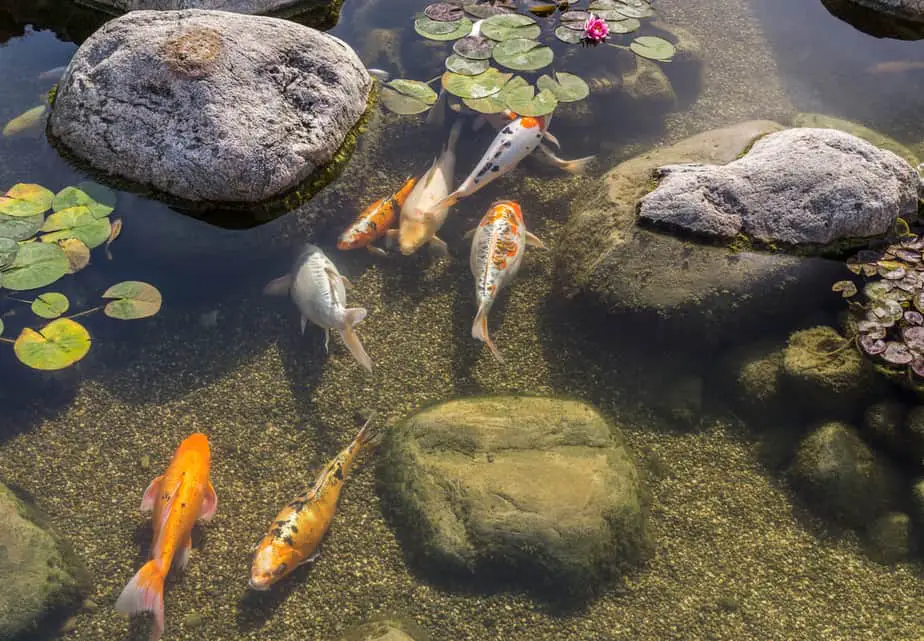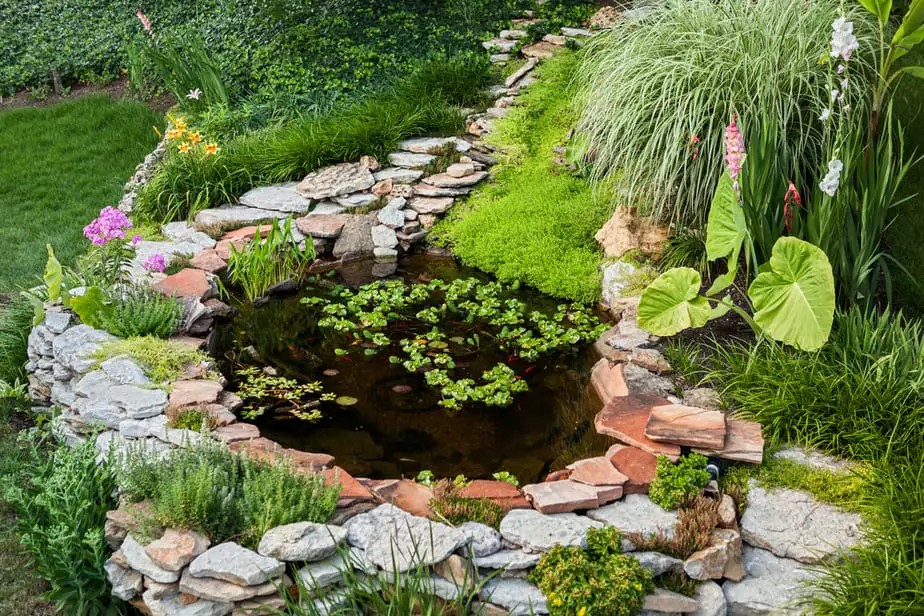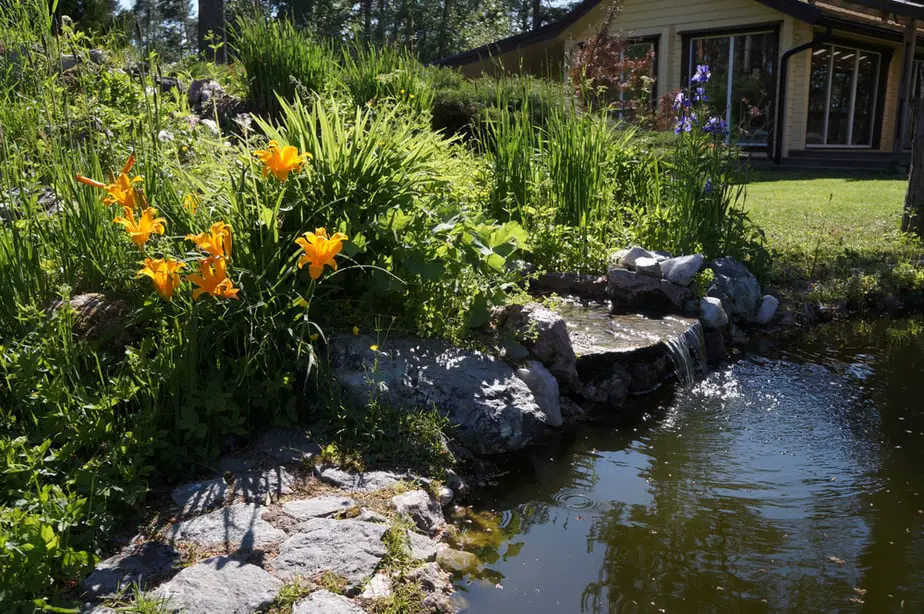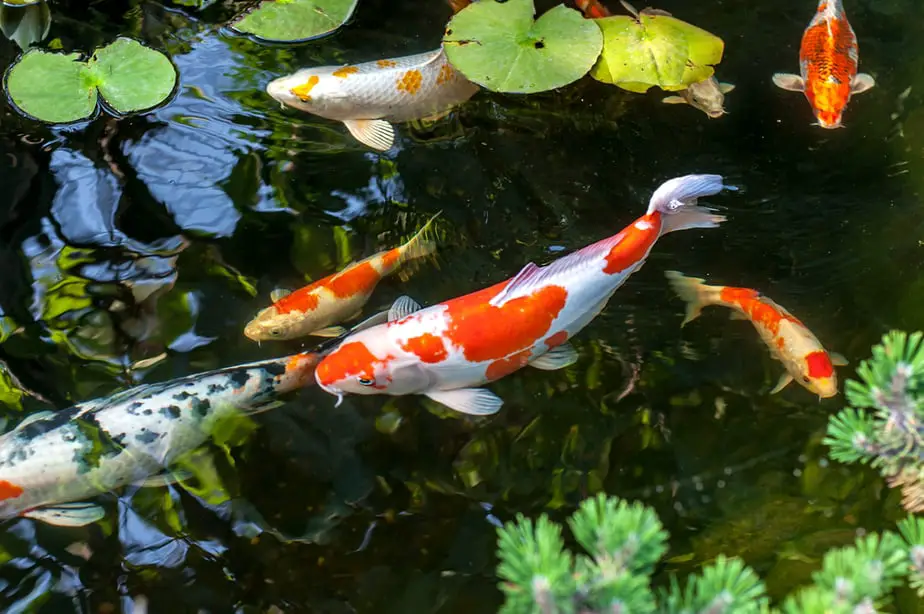There’s nothing quite like tranquility in the garden, and what better way to achieve that than with a koi pond?

While not officially landscape, koi ponds are formal-style fish ponds that nestle within and enhance the surrounding landscape. Landscaping can be placed right up to and overhanging koi ponds.
Table of Contents
Designing Your Koi Pond

Every good design begins with a plan, and a plan on paper will make it easier to visualize what you may need. Consider where your koi pond will be placed, what materials you will need, and in what quantities. Dream as big as your space and budget allow. Determine the size of your koi pond, including details like depth, filtration system, and water volume.
When choosing the location of your koi pond, consider the position of existing structures such as underground utility pipes. You don’t want to strike one of those when you begin digging your tranquil water garden.
Get the most out of your koi pond by positioning it with clear visibility from the house so you can enjoy it both indoors and out. Koi ponds generally flourish in shaded areas because the shade tends to slow the growth of algae. It may also prevent the water from getting too hot during summer.
Your design should reflect your lifestyle and taste. Popular koi pond styles include the modern look, the natural feel, multi-layered ponds and koi ponds with waterfalls. These styles are created by the materials that you choose to use when constructing your koi pond, what plants you include, and the surrounding landscape.
All koi ponds and waterfalls need a circulating pump, make sure the one you use has enough power for the size of your koi pond, how high you need to pump water and how fast you want the flow rate.
As the heart of your koi pond, the water filter is not the item to try to save money on. It serves as a mechanical filter, removing koi fish waste and anything else in the koi pond that would cloud the water and as a biological filter by converting the ammonia produced by the koi fish into nitrites and eventually to nitrates, which are generally harmless to the koi fish.
Ultraviolet light is used to make algae form into clumps to be removed by mechanical filtration. An ultraviolet sterilizer will also kill free-floating bacteria in the pond water.
Koi fish are unable to regulate their own body temperature, which can impact their growth and health. A pond heater can warm the water of the pond to the regulated temperature, in the case of koi fish it should be between 12.778 degrees Celsius and 25 degrees celsius. The three most popular heaters for koi ponds are deicers, inline electric water heaters, and gas-fired boilers. Which you choose depends on the pond size and your budget.
Constructing Your Koi Pond
Your design has been finalized. Now it is time to turn your dream into a reality. Put your paper plan on the ground in real size. This is outlining. Make sure your outline includes space for the filtration system.
Contact your local plant hire place and get your hands on a small excavator. It will make digging easier and a whole lot more fun. Excavate at least one foot longer than the actual koi pond in every direction to allow for the construction of retaining walls, and don’t backfill around the fish pond structure until all pipes have been installed. Be sure to incorporate multiple levels in your koi pond for future planting.
Now you need a bacteria tank to keep your koi alive by helping the bacteria koi create to keep the water specifically conditioned for them. Bacteria tanks are often used as waterfalls to run down over rocks into the koi pond and circulate the water. You can use the dirt from the hole you’ve just dug to create your waterfall structure.
Line your hole, making sure that the liner is as smooth as possible, has an X cut into it for the bottom drain, and extends about a foot out of the hole in all directions. Anchor the liner with large rocks.
Install the water pump an inch or two from the bottom of the pond so it doesn’t suck up sediment, and pop in your water filter.
Landscaping
Edge the koi pond by choosing a material to hold the liner in place. Large rocks are great for a natural feel or try bricks or tiles for a more modern look.
Planting

Water plants are not just aesthetically pleasing, they fulfill certain functions, such as keeping algae growth down by consuming the same nutrients and providing shade. They also help stabilize pH levels by consuming various metals and other compounds and act as natural sun blockers for koi fish. There are also different styles of water plants.
Bog plants thrive in moist soil, but with just their roots wet. These plants are great for the edges of your pond. Examples include Sarracenia, carnivorous, or pitcher plants, that eat mosquitoes, gnats, and other small insects.
Marginal plants are also suitable for the edges of your koi pond. They live in water up to six inches above the crown of the plant. Examples include Aquatic Iris, which is colorful and grows in full sun to part shade, rush, and cattail varieties, lotus, and hardy, tropical water lilies.
Floating plants double as shade for the koi fish. Varieties of floating plants include water lettuce, water hyacinth, water fern/fairy moss, duckweed, and frogbit. Submerged oxygenators include hornwort and Sagittaria. These plants are planted in the lower levels of the pond koi fish and help oxygenate the water.
As a general idea, there should be at least one bog plant and one marginal plant per 5sq ft, providing for a lush pond edge, one submerged plant every 100sq ft, one floating plant every 10sq ft and one water lily for every 50 square feet of pond water area with depths of 2 feet or less. Have a mix of blooming and non-blooming plants, and you want some blooms from spring through to autumn.
Water Parameters for Koi Ponds
Fill the koi pond with fresh water and make sure it retains the water. Let the water circulate and build up some sediment before adding your koi fish.
The ideal range for nitrate is 20 – 60 ppm (parts per million). If your pond water reaches 80ppm you should begin a regimen of partial water changes to reduce nitrates to a safe level. Nitrate becomes extremely toxic above 120ppm. Naturally occurring algae that develop on the inside walls of the pond is usually sufficient to keep nitrates at a safe level without planting if you choose not to plant.
Further safeguard your koi fish by installing a floating mesh that is invisible from a distance, but will prevent birds and land animals from snatching the koi fish from your pond. Predators will not be able to reach through the mesh to eat your fish.
Adding Koi Fish

Keep a test kit on hand and perform all relevant tests to make sure the nitrogen cycle has finished. It won’t take as long if you add bacteria beforehand. When the ammonia and nitrite levels spike before returning to zero your koi pond is ready for fish. This cycle can take anywhere from 2 to 8 weeks.
Don’t just toss your koi in the pond. They need to be acclimated first. Float the bags on the pond’s surface for 30 minutes then add a cup of water to the bags every five minutes for the next 20 to 30 minutes. Gently pour the koi fish from the bags into a net above a bucket and add to the pond. Don’t add the water from the bag to the pond.
Maintaining Your Koi Pond
It is critical for the health and quality of the koi fish to properly and regularly clean the mechanical and biological filters of koi ponds. Mechanical filters should be back washed or cleaned out often. Make sure you clean out any dead vegetation to prevent filter obstructions and algae growth that will use up much-needed oxygen for your koi fish and plants.
The purpose of the skimmer is to collect leaves, pollen, twigs, uneaten food, and all other kinds of floating debris from the water garden. It usually has a cleanout basket that can be quickly emptied on a regular basis to allow it to run properly. Most floating skimmers also have a foam that sits underneath the basket to filter out finer particles.
Final Thoughts
Koi ponds are excellent additions to backyards that provide your outdoor space with a calming ambiance and beautiful colors and textures. Constructing your own koi pond isn’t as difficult as some may think and maintenance, though somewhat time-consuming, will keep your pond in top-notch shape and your colorful fish happy and healthy.